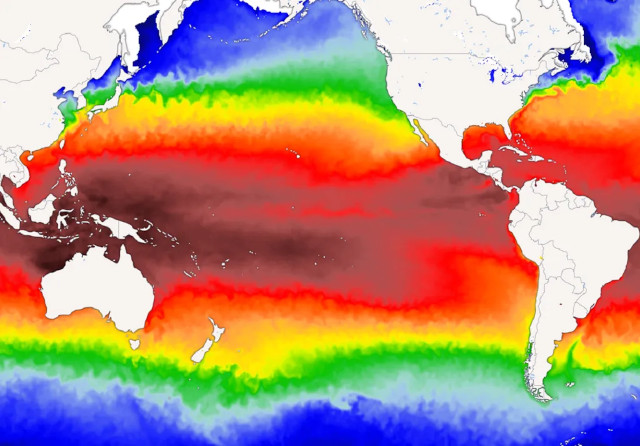
On April 16, 2023, the National Oceanic and Atmospheric Administration (NOAA) issued an El Nino Watch as part of its April ENSO outlook. This watch indicates that conditions are favorable for developing an El Nino event within the next six months, between May and July 2023. The El Nino Watch comes after nearly two straight years of La Nina conditions, which have had their climatic impacts. Currently, we are in an ENSO-neutral phase, meaning neither El Nino nor La Nina is present.
Understanding ENSO
The El Nino-Southern Oscillation (ENSO) is one of the most significant climate patterns affecting weather patterns worldwide. It is a complex phenomenon caused by fluctuations in ocean temperatures in the equatorial Pacific Ocean. The three phases of ENSO, El Nino, La Nina, and neutral, significantly impact global climate patterns, causing changes in rainfall, temperature, and storm frequency. The El Nino phase is associated with warmer and drier weather in the western Pacific. In contrast, La Nina is associated with cooler and wetter conditions in the same region. In comparison, ENSO's neutral phase minimizes the impact on global weather patterns.
ENSO can profoundly impact the global economy and human activities, including agriculture, fisheries, and water resources management. The El Nino phase, for example, can cause severe droughts in the western Pacific, leading to crop failures and food shortages. On the other hand, the La Nina phase can result in flooding and landslides, causing significant damage to infrastructure and affecting transportation and commerce. Understanding the ENSO phenomenon and its impact on the global climate system is crucial for developing effective climate change mitigation and adaptation strategies.
Impacts of El Nino on Global Weather Patterns
The development of an El Nino event could have wide-ranging implications for global weather patterns. Typically, El Nino is associated with warmer and drier conditions across the northern tier of the United States, while the southern tier experiences cooler and wetter conditions. The jet stream, a high-altitude river of air that steers weather systems, often shifts during El Nino events, affecting temperature and precipitation patterns across North America.
Internationally, El Nino can lead to droughts in Australia, increased precipitation in South America, and altered monsoon patterns in Asia. The increased rainfall can result in flooding in countries like Peru and Ecuador. At the same time, East Africa may experience below-average rain, leading to food shortages and famine. Furthermore, the Indian subcontinent could see a weakened monsoon season, affecting agriculture and water availability for millions of people.
The Relationship Between El Nino and Climate Change
Although El Nino events are natural phenomena, there is increasing evidence that climate change may influence their frequency and intensity. As global temperatures continue to rise due to human-induced greenhouse gas emissions, the oceans' heat content also increases, potentially affecting the occurrence of El Nino events.
Some experts predict that if this developing El Nino event is as severe as some past occurrences, we could see a temporary temperature rise of over 1.5°C. This potential spike in temperature would provide a glimpse of the future climate as global temperatures are expected to rise past 1.5°C on the way to the 2.0°C mark. Such a temperature increase could exacerbate climate challenges, such as more frequent and severe heatwaves, intensified storms, and disrupted ecosystems.
Impacts on Agriculture and Food Security
El Nino events can have significant consequences for agriculture and food security worldwide. For example, during the 2015-2016 El Nino event, severe drought conditions in southern Africa led to crop failures and food shortages, affecting millions of people. Similarly, El Nino-driven weather patterns can impact agricultural production in the United States, where drought conditions may reduce crop yields in some areas. In contrast, excessive rainfall in others can lead to flooding and crop damage.
The fishing industry is also vulnerable to El Nino events, as changes in ocean temperatures can disrupt marine ecosystems and alter fish migration patterns. During intense El Nino events, fisheries in the eastern Pacific often experience declines in catch rates, impacting coastal communities that rely on fishing for their livelihoods and food supply. Conversely, some regions may experience a temporary increase in fish stocks as species migrate in response to changing ocean conditions.
Impacts on Ecosystems and Wildlife
El Nino events can have profound effects on ecosystems and wildlife across the globe. The altered weather patterns can lead to habitat disruptions, changes in food availability, and shifts in migration patterns for various species. For instance, the warmer ocean temperatures associated with El Nino can cause coral bleaching. Corals expel the algae living within their tissues, resulting in a loss of color and increased susceptibility to disease and death.
Additionally, El Nino-driven weather changes can expand disease vectors, such as mosquitoes, into new areas, increasing the risk of infectious diseases for both humans and wildlife. The warmer, wetter conditions associated with El Nino may also contribute to the proliferation of harmful algal blooms, negatively affecting marine life and coastal communities.
Economic and Societal Consequences
The widespread climatic impacts of El Nino events can also have significant economic and societal consequences. The agricultural challenges associated with altered weather patterns can lead to higher food prices and increased economic instability in affected regions. This can be particularly devastating in developing countries, where many rely on subsistence agriculture.
Furthermore, increased flooding and extreme weather events can damage infrastructure, displacement of communities, and loss of life. The costs associated with disaster response and recovery can significantly burden governments and international aid organizations, diverting resources from other pressing needs.
Preparedness and Adaptation
As scientists continue to monitor this potential El Nino, policymakers, businesses, and individuals must remain informed and prepared for the potential impacts on weather patterns, agriculture, and ecosystems. By understanding the challenges El Nino events pose, communities can better adapt and build resilience in a changing climate.
Enhancing preparedness includes:
- Investing in early warning systems.
- Improving infrastructure to withstand extreme weather events.
- Implementing sustainable agricultural practices to increase food security.
Furthermore, international cooperation and coordination are vital in responding to the global challenges posed by El Nino events and mitigating the broader impacts of climate change.
As the world faces the increasing threat of climate change, understanding and preparing for the potential impacts of El Nino events becomes ever more critical. The current El Nino Watch serves as a reminder of the need for continued research, monitoring, and investment in adaptive strategies to ensure the safety and well-being of communities worldwide. By working together, we can mitigate the risks of El Nino and other climate challenges, building a more resilient and sustainable future for all.
About the Author
 Robert Jennings is the co-publisher of InnerSelf.com, a platform dedicated to empowering individuals and fostering a more connected, equitable world. A veteran of the U.S. Marine Corps and the U.S. Army, Robert draws on his diverse life experiences, from working in real estate and construction to building InnerSelf with his wife, Marie T. Russell, to bring a practical, grounded perspective to life’s challenges. Founded in 1996, InnerSelf.com shares insights to help people make informed, meaningful choices for themselves and the planet. More than 30 years later, InnerSelf continues to inspire clarity and empowerment.
Robert Jennings is the co-publisher of InnerSelf.com, a platform dedicated to empowering individuals and fostering a more connected, equitable world. A veteran of the U.S. Marine Corps and the U.S. Army, Robert draws on his diverse life experiences, from working in real estate and construction to building InnerSelf with his wife, Marie T. Russell, to bring a practical, grounded perspective to life’s challenges. Founded in 1996, InnerSelf.com shares insights to help people make informed, meaningful choices for themselves and the planet. More than 30 years later, InnerSelf continues to inspire clarity and empowerment.
Creative Commons 4.0
This article is licensed under a Creative Commons Attribution-Share Alike 4.0 License. Attribute the author Robert Jennings, InnerSelf.com. Link back to the article This article originally appeared on InnerSelf.com
Additional Information
InnerSelf.com has over 5,000 articles on climate change here
What are El Niño and La Niña?
Here NOAA has a brief explanation and video of these weather conditions and how they affect the US weather. Click Here
How El Niño and La Niña Cause Extreme Weather
From the Econmist: El Niño and La Niña are opposite states of one of Earth’s most important climate processes, the El Niño Southern Oscillation, or ENSO. It can lead to devastating weather events all over the world. But how does it work, what kinds of extreme weather does it cause and how is global warming affecting it?



